AMD has been shouting about Kabini’s potential as an APU for basic gaming needs. Across the Kabini range, the on-chip Radeon R3 graphics system sports 128 GCN cores and shares a portion of the system memory.
We test Kabini’s gaming ability at 1280 x 720 and low settings. This represents a basic gaming workload that many entry-level users would be happy to settle for. Less-demanding titles, such as Indie games and the likes of Minecraft, will possess lower GPU requirements and will therefore provide playable frame rates at higher resolutions or image quality settings.
While Kabini is an entry-level range, there has been a lot of interest in the possibility of using the typically quad-core chips as the foundation for a low-cost, high-resolution gaming system. Such requirements would necessitate an upgraded graphics card so we use Sapphire’s 2GB R7 240 Low Profile in combination with the Athlon 5350.
The Sapphire R7 240 Low Profile is a 2GB graphics card operating at a 730MHz core clock which boosts up to a maximum of 780MHz. The 2GB of DDR3 memory is clocked at an effective 1800MHz and uses a 128-bit wide interface.
Crammed onto the 28nm R7 240 GPU are 320 GCN cores that draw less than a PCIe slot-worth of power. Mantle is supported by the R7 240 GPU thanks to its GCN cores.
Sapphire’s unique claim for the R7 240 Low Profile is its pair of HDMI ports. Both of the ports support the usual HDMI benefits, such as; Deep Color, stereoscopic 3D, and high resolutions. Sapphire was keen to point out an interesting feature for its R7 240 Low Profile – the ability to output audio via HDMI to two separate devices. X Factor on the big screen (to keep the other-half happy, of course) and gaming on the desk-mounted monitor, anybody?
An HDMI to single-link DVI adapter is included in the bundle, as is a full-width PCIe slot bracket. A single-slot cooler and miniature fan are used to cool the relatively low-power R7 240 GPU. Dabs currently has the Sapphire graphics card priced at around £60.
Many people will quickly question the point in buying Kabini if a discrete GPU is going to be used. There are a number of situations where I can see this type of scenario occurring. To entry-level consumers, a block of funds capable of purchasing multiple pieces of hardware may be difficult to come by. Kabini allows users to leverage the gaming performance of the on-chip GPU until an upgraded discrete graphics card can be afforded.
Stretching my mind back to my early teenage years when I was building my first system, lumps of cash were difficult to come by. I realised that I could purchase the processor and motherboard at a specific time and then wait a few months before buying a higher-performance graphics card. I did not want to sacrifice playable gaming performance for those few months hence an APU such as Kabini would have been a relevant solution (if it was around at that time).
Bioshock Infinite
We used the Bioshock Infinite's ‘Low’ setting and a 1280 x 720 resolution to push today’s hardware. Our data was recorded using a section of the game, not the built-in benchmark.
At the lowest image quality settings and with a 1280 x 720, Bioshock Infinite is unplayable on the Athlon 5350-powered system. There's no denying that the level of performance offered by the R3 graphics system is respectable, but a resolution decrease would be required to provide playable frame rates.
Achieving strong frame rates with a 2GB Sapphire R7 240 graphics card added into the system proves that the Athlon 5350's CPU performance is sufficient for basic gaming tasks. Cranking the resolution up to 1920 x 1080 also resulted in borderline playable frame rates (just shy of 30 FPS), further proving that the Athlon 5350 can be used for gaming with low image quality settings.
CPU bottlenecking did not show its ugly head; there was a noticeable change in frame rates when switching from a resolution of 720 to 1080.
DiRT Showdown
We used a 1280 x 720 resolution and DiRT Showdown's built-in benchmark set to ‘Ultra Low’ quality to check if the Athlon 5350 APU was capable of providing playable frame rates in a less-demanding game.
At a resolution of 1280 x 720 and with the lowest image quality settings, DiRT Showdown is perfectly playable on the Athlon 5350-based system. The Radeon R3 graphics keep DiRT Showdown chugging away at more than 30 FPS.
Adding the 2GB Sapphire R7 240 graphics card into the mix does provide a decent bump in frame rates. Further testing showed that switching up to a 1920 x 1080 resolution with the discrete graphics card being used resulted in CPU-limited performance. An increase in the resolution did not change the recorded frame rates hence the entry-level Athlon 5350's CPU performance is acting as a bottleneck.
3DMark (with 2GB Sapphire R7 240 Low Profile graphics card)
A considerable boost in the 3DMark Fire Strike score is achieved when the Sapphire R7 240 Low Profile graphics card is added into the system. Graphics score increased almost three-fold and the overall 3DMark result was almost four-times higher.
Noise and temperatures were not issues with the Sapphire graphics card; the miniature fan was not audible over the reference AMD heatsink, and the single-slot cooler did a good job at keeping the GPU temperature below 50C while gaming.
 KitGuru KitGuru.net – Tech News | Hardware News | Hardware Reviews | IOS | Mobile | Gaming | Graphics Cards
KitGuru KitGuru.net – Tech News | Hardware News | Hardware Reviews | IOS | Mobile | Gaming | Graphics Cards


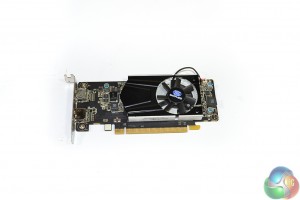
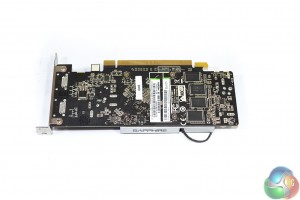
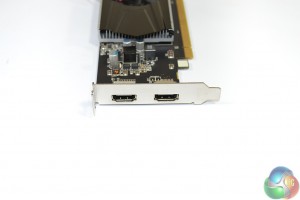
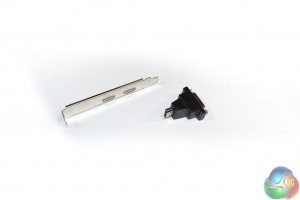
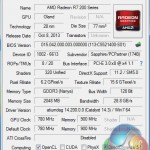
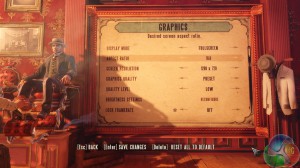
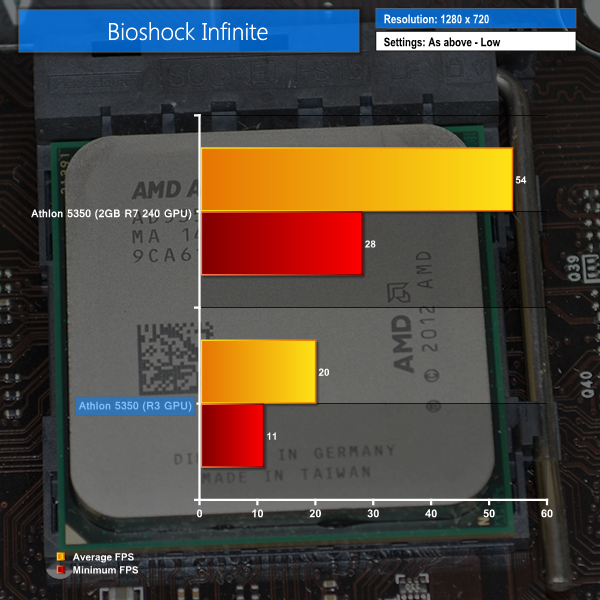
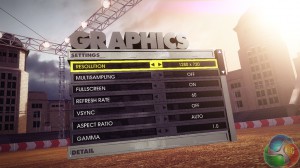
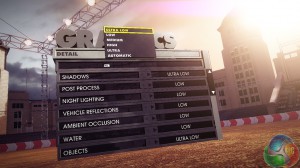
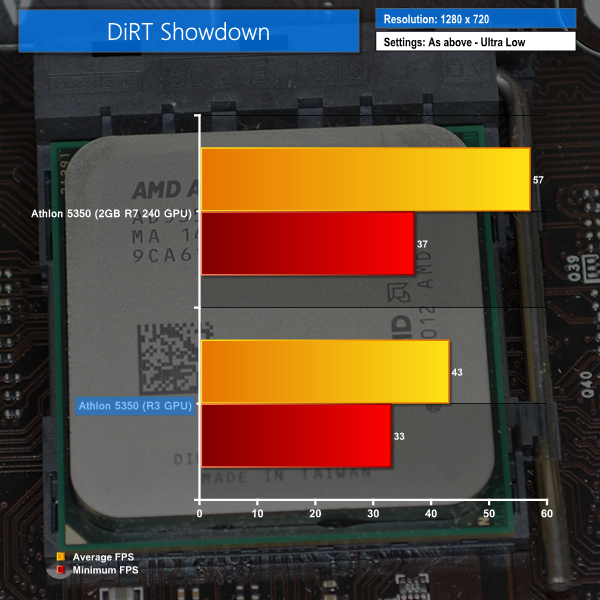
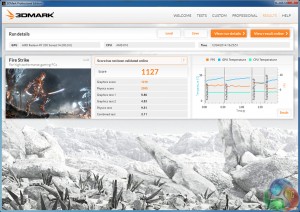
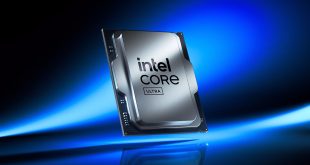
does the Single-Channel memory slow down add-on GPU cards as well ?
wonder how much slower the CPU will be with a older gDDR5 mid-rangeR7 card
I already got a R7 260x looking for a home for a 1.1/2 year till the upgrade
wonder if moving to a cheap FM2 is best ! ??
I am running this cpu with an AMD RX 480. Just for the lulz and while i wait for my Intel CPU.
Only register to say this: What in the hell was thinking the article maker, attacking that fake picture of the GPUZ ? I bought this piece of crap thinking the data was legit, just to find he take some random picture from internet from the hd 8400 card, and put that here. The real performance from the APU chip is 12,8 gb/sec, not 25,6.. You just ruin my build and make me to waste money (i already have a sempron 3850 who its GPU performs exactly the same. Damn internet, i dunno why i keep trusting jhon doe reviewers.
Correct the data with real gpuz info dude, before more people makes a mistake.
Man, did AMD screw up marketing this thing. “Rebranding” the socket from FSb1 to AM1 was a feat of search engine de-optimization. Marketing morons.